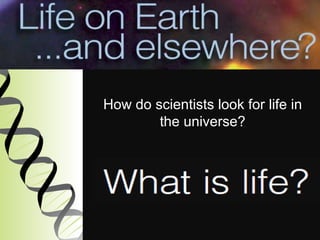
Characteristics Of Life
- 1. Images and activities adopted from NASA Astrobiology Institute - Life on earth …and elsewhere? How do scientists look for life in the universe?
- 2. You are an explorer in the future . You have discovered the remains of an unknown organism . You are particularly interested in knowing the origins of the new species and the mechanisms that led to its evolution. PERFORMANCE TASK You will appear before your colleagues (fellow explorers) to present your discovery.
- 3. http://www.newscientist.com/article/mg20727740.201-found-worlds-oldest-animal-fossils.html?DCMP=OTC-rss&nsref=life http://www.cbc.ca/technology/story/2010/08/18/sponge-fossils-animal-australia.html The Search for understanding our Identity continues…
- 4. What is Life? A. Flame B. Tree vs. pencil C. Real grass vs. artificial grass
- 5. M ovement R espiration S ensitivity G rowth R eproduction E xcretion N utrition http://www.s-cool.co.uk/gcse/biology/cells/characteristics-of-life.html Quick Review:
- 7. There is no firm scientific definition of life , no single test that can establish the presence or absence of life, and no single characteristic that applies to all living things. • There are characteristics that almost all living creatures share . • Two characteristics useful in helping distinguish life from non-life are the ability to reproduce and the ability to produce and perpetuate genetic variation among offspring.
- 8. ACTIVITY 1: EVIDENCE OF LIFE Which of these two samples: powder and blob are living? Why? Sample A: Powder Sample B: Blob To find out: Place the 2 samples in water. Observe. Note: Organize a notebook page. Write answers in your notebook.
- 10. MAKING BIOLOGICAL DRAWINGS
- 11. Specimen 1 Lines parallel ; labels are ruler drawn and right hand side
- 12. SAMPLE - Detailed drawing
- 17. LIFE The Most Basic Needs
- 18. MAKING PREDICTIONS: Predict what might grow in these given situations.
- 20. Many astrobiologists use the availability of liquid water as the primary criterion for judging whether a planet is a candidate for life. While other liquids do exist (e.g., ammonia, methane, or ethane), they exist at temperatures far below the level conducive for life. The life discovered to date seems to be limited to a temperature range of about minus 15°C to 115°C. Under the right conditions, water can be liquid over this entire range. WATER
- 21. All life requires energy. Organisms use either light energy or chemical energy to run their life processes. Light energy is available only to organisms that live on or close to a planet or moon’s surface. For life to exist there, the surface must be within a temperature range conducive for life and be protected from harmful ultraviolet radiation and charged solar particles. Organisms that live beneath the ground depend on chemical energy for their needs. ENERGY
- 22. Nutrients are the raw materials organisms need to construct and maintain their bodies . While the solid planets and moons in our solar system all have the same general composition, local conditions and processes have led to variations in the concentrations and availability of different chemical compounds. As a result, nutrients required by life are more available on some planets and moons than on others. Atmospheres can also serve as a source of nutrients. For example, nitrogen from nitrogen gas can be used to make proteins and carbon from carbon dioxide or methane can be used to make carbohydrates and fats. NUTRIENTS
